Drugs in Blood and Urine
Indomethacin was analyzed using Asahipak ODP-50 6E (a column for reversed phase chromatography). Indomethacin is a steroid-free, anti-inflammation drug used for rheumatism, inflammation of arthritis and podagra and is known to have strong side effects on the central nervous system and digestive organs. This is an example of a high sensitive analysis of indomethacin by using the principle that it converts to a fluorescent substance by alkaline hydrolysis at high temperature.
1) Use an ODP column with an eluent of pH10.
2) Set a heating coil at postcolumn.
3) Only one pump is necessary. Since the eluent is alkaline, postcolumn mixing is unnecessary.
4) The indomethacin is converted into fluorescent substance by alkaline hydrolysis in the heating coil, a highly selective and sensitive analysis is possible.
(Sample pre-treatment)
1) Add 20 micro-L of CH3CN to 20 micro-L of serum
2) Stir (2 to 3 sec)
3) Centrifuge (10,000G , 2min)
4) Skim supermatant and inject

Sample : Indomethacin
Column : Shodex Asahipak ODP-50 6E (6.0mmID*150mm) Eluent : 25mM Sodium phosphate buffer(pH10.0)/CH3CN=65/35 Flow rate : 1.0mL/min Detector : Fluorescence detecotr(Ex.298nm , Em.375nm) Column temp. : Room temp. Post column : Heating coil at 140deg-C is followed with cooling coil reaction at 15deg-C
H. Kubo, Y.Umiguchi, T.Kinoshita, Chromatographia Vol.33, No.7/8, 1992
This shows one advantage of using an alkaline eluent for the analysis of procainamide in serum such as procainamide. Procainamide cannot be separated from other serum components at pH 3 or 7. However, since procainamide, which is one of a tertiary amine, dissociates a little at pH11, in consequence, it is strongly retained by the packing material of Asahipak ODP-50 4D ( a column for reversed phase chromatography ) and can be separated from other serum components.
As explained above, for the analysis of basic drugs which have tertiary amino groups, an alkaline eluent at pH11 is effective.
1) Dissolve procainamide in CH3CN (1.0mg/mL).
2) Put 10 micro-L of the above in the centrifuge tube and blow dry it.
3) Add 1,000 micro-L of the serum and stir.
4) Add 3,000 micro-L of CH3CN and stir.
5) Centrifuge (3,500rpm , 20min) skim and filtrate by using a 0.45 micron filter to make a sample.
6) Inject 20 micro-L of the sample.
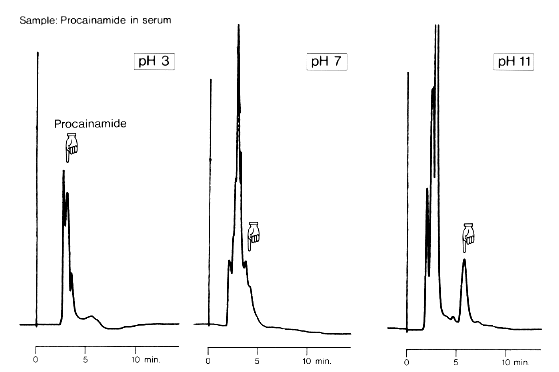
Sample : Procainamide in serum
Column : Shodex Asahipak ODP-50 4D (4.6mmID*150mm) Eluent : 25mM Phosphate buffer/CH3CN=75/25 Flow rate : 0.6mL/min Detector : UV(254nm) Column temp. : 30deg-C
With Asahipak GS-320 7G, a multimode column, it is possible to make the direct analysis of drug components in serum and urine without sample pretreatment. Proteins, nucleic acids and polysaccharides are eluted first by GFC mode, and then, drugs and metabolites, whose hydrophobic interaction is larger, are eluted by reversed phase mode. This method can be used for the analysis of extracted fluid from serum, urine and internal organs.
GS-320 7G is an old type of GS-320 HQ.
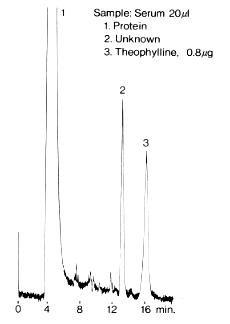
Sample : Serum
1. Protein
2. Unknown
3. Theophylline
Column : Shodex Asahipak GS-320 7G (7.5mmID*500mm) Eluent : 0.01M Sodium acetate (pH4.0)/CH3CN=10/1 Flow rate : 2.0mL/min Detector : UV(280nm) Column temp. : Room temp.
Courtesy of Dr. Nimura, Kitazato University
With Asahipak GS-320 7G, a multimode column, it is possible to make the direct analysis of drug components in Serum and urine without sample pretreatment. Proteins, nucleic acids and polysaccharides are eluted first by GFC mode, and then, drugs and metabolites, whose hydrophobic interaction is larger, are eluted by reversed phase mode. This method can be used for the analysis of extracted fluid from serum, urine and internal organs.
GS-320 7G is an old type of GS-320 HQ.
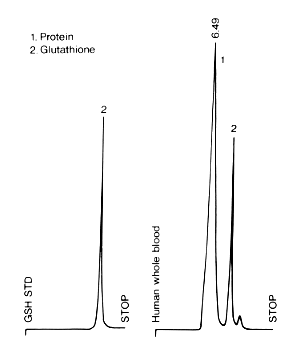
Sample :
1. Protein
2. Glutathione
Column : Shodex Asahipak GS-320 7G (7.5mmID*500mm) Eluent : 40mM EDTA-3Na(pH8.0) Reagent : 0.8mg/mL OPA in 20% CH3OH (for Post-column reaction) Flow rate : 1.0mL/min Detector : Fluorescence(Ex. 350nm, Em. 420nm)
Courtesy of Dr. Nimura, Kitazato Unversity
With MSpak GF-310 4B, a column for LC/MS, it is possible to make the direct analysis of drug components in serum without sample pretreatment.


Sample : Hexobarbital
(HPLC) Instrument : Agilent 1100 Column : Shodex MSpak GF-310 4B (4.6mmID*50mm) Eluent : 50mM CH3COONH4/CH3CN=80/20 Flow rate : 0.5mL/min Detector : UV(220nm) Column temp. : 35deg-C (MS) Instrument : Agilent 1100MSD Mass range : 105-500(m/z) Ionization : Electrospray Nebulizer : N2(50psi) Drying gas : N2(12L/min, 350deg-C) Mode : Positive SIM (m/z=281)
Phenobarbital in serum was analyzed using a column for rapid analyses of medicines, MSpak GF-310 4B. First, large molecular weight portion, serum proteins was eluted, and then, phenobarbital which had interaction of adsorption and partition with packing material was eluted.
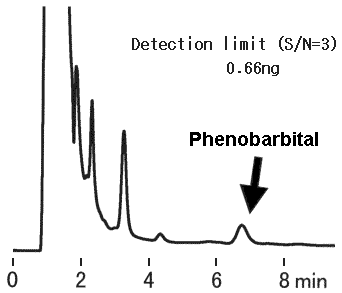
Sample : 2micro-L
5micro-L/mL Phenobarbital in Control serum I Wako
(from Wako Chemicals Indusries, Ltd.)
Column : Shodex MSpak GF-310 4B (4.6mmID*50mm) Eluent : 50mM CH3COONH4/CH3CN=70/30 Flow rate : 0.25mL/min Detector : UV(220nm) Column temp. : 30deg-C
With sahipak AGS-320 7G, a multimode column, it is possible to make the direct analysis of drug components in serum blood and urine without sample pretreatment. Proteins, nucleic acids and polysaccharides are eluted first by GFC mode, and then, drugs and metabolites, whose hydrophobic interaction is larger, are eluted by reversed phase mode. This method can be used for the analysis of extracted fluid from serum, urine and internal organs.
GS-320 7G is an old type of GS-320 HQ.

Sample :
1. Ephedrine and Methylephedrine
2. Amphetamine
3. Methamphetamine
Column : Shodex Asahipak GS-320 7G (7.5mmID*500mm) Eluent : 0.02M NaHCO3/CH3CN=80/20 Flow rate : 1.0mL/min Detector : UV(207nm) Column temp. : 40deg-C
Hosoi , EISEI KAGAKU , 33 (3) (1987) 170.
Biological sample was analyzed directly using ODP2 HP. ODP2 HP is polymer based reversed phase column. One of advantage of ODP2 HP is very low adsorption of protein, because the surface of the packing material is high polar and the pore size is small. Since proteins like BSA are eluted early and its peak shape is sharp. ODP2 HP can separate drugs from proteins. Four LC/MS chromatograms of barbital were shown. These are comparison of using ODP2 HP and ODS, and barbital without BSA and with BSA. In using ODS (right), the peak height of barbital with BSA were lower than without BSA. It means there was ion suppression by existence of BSA. The comparison data of recovery of barbital also showed influence of BSA to ODS. ODP2 HP can be used for analysis of low molecular compounds in biological sample without bad influence of protein.
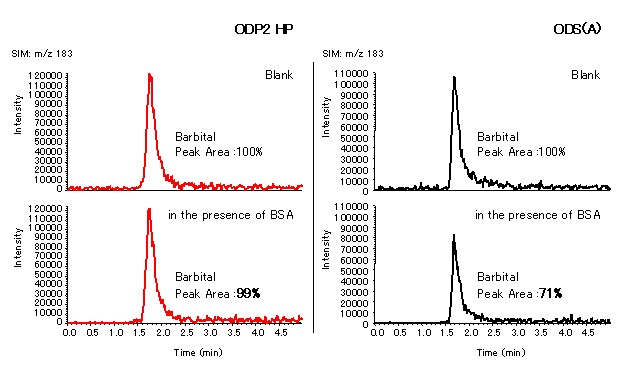
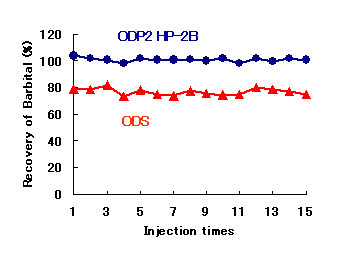
Sample : Barbital (500ng/L) in BSA (7.0mg/L), 10micro-L
1. Barbital
Column : Shodex ODP2 HP-2B, ODS from other manufacturer(2.0mmID*50mm esch) Eluent : 10mM Ammonium acetate/CH3CN=70/30 Flow rate : 0.2mL/min Detector : ESI-MS (SIM negative) Column temp. : 30deg-C
LC/MS is effective for the high sensitivity analysis of drugs; however, when protein is present and enters the MS (Mass Detector), it contaminates the MS or suppresses ionization of the sample. Pretreatment does not often remove protein thoroughly. Drugs in biological fluid are hard to analyze because protein co-elutes with the component of interest. The target drug receives ion suppression from the protein and appears as a small peak. ODP2 HP can separate the target from protein by eluting protein early and clearly. Barbital was introduced into the MS by a switching valve after BSA (protein) was eluted, and barbital was detected without any influence of ion suppression.

Sample : Barbital (500ng/mL) in BSA (7.0mg/L), 10micro-L
Column : Shodex ODP2 HP-2B (2.0mmID*50mm esch) Eluent : 10mM Ammonium acetate aq./CH3CN=70/30 Flow rate : 0.2mL/min Detector : UV(280nm), ESI-MS(SIM negative) Column temp. : 30deg-C
LC/MS analysis of drugs in BSA was performed using polymer-based column ODP2 HP. Each drug has peak areas between 83 -100 % (peak areas without BSA are set as 100 %), which means a good separation without receiving ion suppression from protein.
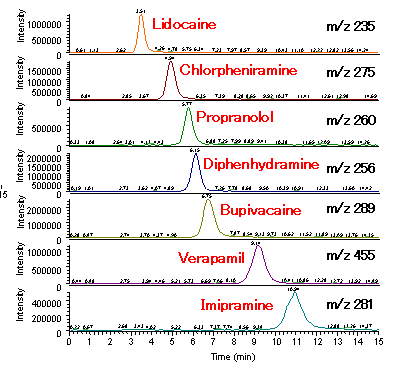
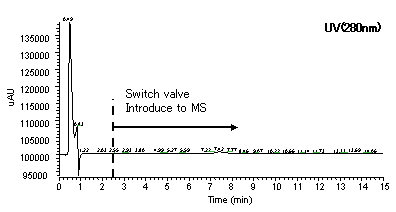
Sample : drugs 500ng/mL each in BSA (7.0mg/L), 5micro-L
Lidocaine
Chlorpheniramine
Propranolol
Diphenhydramine
Bupivacaine
Verapamil
Imipramine
Column : Shodex ODP2 HP-2B (2.0mmID*50mm) Eluent : 10mM Ammonium acetate aq./CH3CN=70/30 Flow rate : 0.2mL/min Detector : UV(280nm), ESI-MS (SIM Positive) Column temp. : 40deg-C
LC/MS analysis of drugs in control serum after removing proteins was done by polymer-based column ODP2 HP. Each drug has peak areas between 82 – 111 % (peak areas without BSA are set as 100 %), which means a good separation without receiving ion suppression from protein.
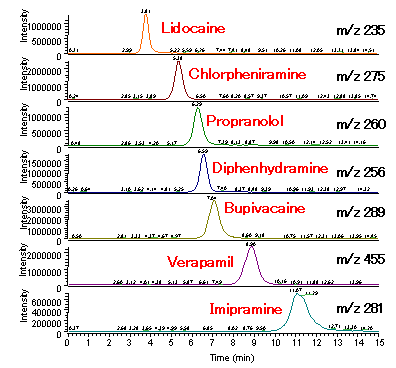

Sample : drugs 500ng/mL each in Control serum, 5micro-L
Lidocaine
Chlorpheniramine
Propranolol
Diphenhydramine
Bupivacaine
Verapamil
Imipramine
Column : Shodex ODP2 HP-2B (2.0mmID*50mm) Eluent : 10mM Ammonium acetate aq./CH3CN=70/30 Flow rate : 0.2mL/min Detector : UV(280nm), ESI-MS (SIM Positive) Column temp. : 40deg-C
Reproducibility for drug analysis in protein (BSA) was confirmed using polymer-based ODP2 HP. The separation remains good even after 150 runs.
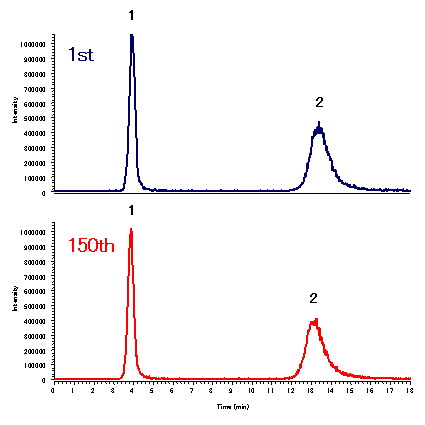
Sample : 500ng/mL each in 0.7mg/mL BSA, 5micro-L
1. Lidocaine
2. Imipramine
Column : Shodex ODP2 HP-2B (2.0mmID*50mm)
Eluent : 10mM Ammonium acetate aq./CH3CN=70/30
Flow rate : 0.2mL/min
Detector : ESI-MS (TIC positive)
m/z 235; Lidocaine
m/z 281; Imipramine
Column temp. : 40deg-C
This shows LC/MS analysis of drugs in BSA with a gradient using polymer-based ODP2 HP. Each drug has peak areas between 98 – 107 % (peak areas without BSA are set as 100 %), which means a good separation without receiving ion suppression from protein.
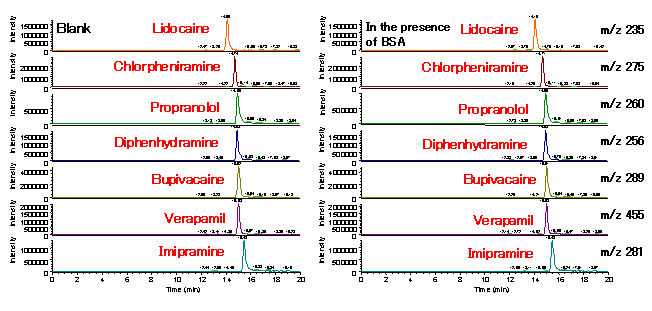
Sample : drugs 500ng/mL each in BSA (7.0mg/L), 5micro-L
Lidocaine
Chlorpheniramine
Propranolol
Diphenhydramine
Bupivacaine
Verapamil
Imipramine
Column : Shodex ODP2 HP-2B (2.0mmID*50mm)
Eluent : (A);10mM Ammonium acetate aq.
(B);100mM Ammonium acetate aq./CH3CN=10/90
gradient; (A) to (A) to 70%(B) to 70%(B) to (A),
0min to 5min to 10min to 15min to 15.01min
Flow rate : 0.2mL/min
Detector : ESI-MS (SIM Positive)
Column temp. : 40deg-C
The HPLC analysis of drugs in biological fluids usually requires the removal of the proteins present in the sample to avoid column contamination. This is not the case with the ODP2 HP reversed phase chromatography column. A high removal rate of sample proteins can be achieved thanks to the packing surface’s high polarity and small pore size. With ODP2 HP, proteins are naturally evacuated as waste product, resulting in shortened sample pre-treatment times. In this application, acetaminophen was analyzed in blood serum injected directly into the column without any pre-treatment.
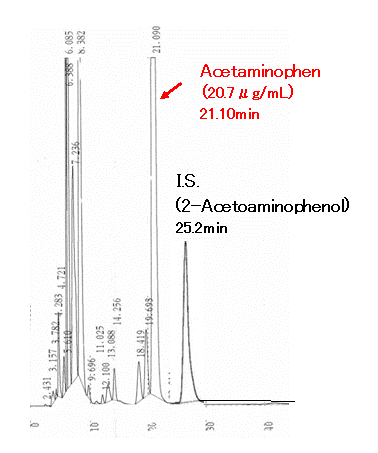
Sample : Human serum, 10micro-L
Acetaminophen
2-Acetaminophenol
Column : Shodex ODP2 HP-4D (4.6mmID*150mm) Eluent : 0.1% TFA:CH3CN=93:7 Flow rate : 0.5mL/min Detector : UV (254nm) Column temp. : 40deg-C
Data courtesy of Katsuko Hara.MT Yutaka Komiyama.PhD,
Department of Clinical Sciences and Laboratory Medicine, Kansai Medical University.
The HPLC analysis of drugs in biological fluids usually requires the removal of the proteins present in the sample to avoid column contamination. This is not the case with the ODP2 HP reversed phase chromatography column. A high removal rate of sample proteins can be achieved thanks to the packing surface’s high polarity and small pore size. With ODP2 HP, proteins are naturally evacuated as waste product, resulting in shortened sample pre-treatment times. In this application, Risperidone was analyzed in 5-fold diluted urine injected directly into the column without further pretreatment.
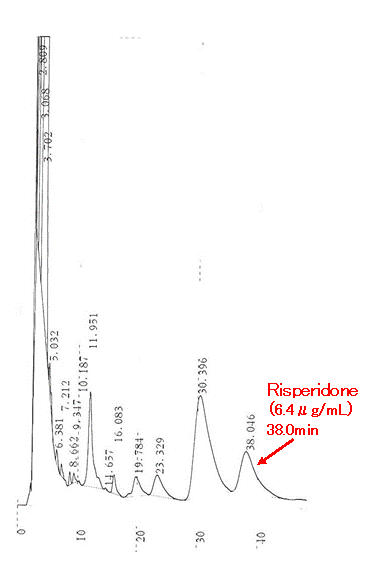
Sample : Human urine (5 fold diluted), 10micro-L
Risperidone
Column : Shodex ODP2 HP-4D (4.6mmID*150mm) Eluent : 0.1% TFA:CH3CN=93:7 Flow rate : 0.6mL/min Detector : UV (215nm) Column temp. : 40deg-C
Data courtesy of Katsuko Hara.MT Yutaka Komiyama.PhD,
Department of Clinical Sciences and Laboratory Medicine, Kansai Medical University.
